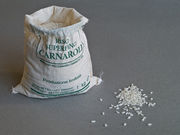Risotto

Risotto is a traditional Italian rice dish cooked with broth and flavored with parmesan cheese and other ingredients,[1] which can include meat, fish, or vegetables. The name means literally "little rice"[2] and it is one of the most common ways of cooking rice in Italy.
Its origins are in northern Italy, specifically Eastern Piedmont, Western Lombardy, and the Veneto, where rice paddies are abundant. Risottos are made using short-grain rice (italian cultivars of Oryza sativa japonica), with the stock being added gradually while the rice is stirred constantly. The cooking technique leads the rice to release its starch, giving the finished dish a creamy texture.
Contents |
Rice varieties
A high-starch (amylopectin), low-amylose round medium- or short- grain rice is usually used to make risotto. Such rices have the ability to absorb liquids and to release starch and so they are stickier than the long grain varieties. The principal varieties used in Italy are Carnaroli[3] and Vialone Nano[4] and to a lesser degree Arborio.[5] Carnaroli and Vialone Nano are considered to be the best (and most expensive) varieties, with different users preferring one over the other. They have slightly different properties: for example Carnaroli is less likely to get overcooked than Vialone Nano, but the latter being smaller cooks faster and absorbs condiments better. Other varieties like Roma, Baldo, Ribe and Originario may be used but will not have the creaminess of the traditional dish. These varieties are considered better for soups and other non-risotto rice dishes and for making sweet rice desserts. Rice designations of Superfino, Semifino and Fino refer to the size and shape (specifically the length and the narrowness of the grain) of the grains and not the quality.
Basic preparation
There are many different risotto recipes with different ingredients, but they are all based on rice of an appropriate variety cooked in a standard procedure.
The rice is first cooked briefly in butter or olive oil to coat each grain in a film of fat, this is called tostatura; white wine is added and has to be absorbed by the grains. When it has evaporated, the heat is raised to medium high and very hot stock is gradually added in small amounts while stirring gently, almost constantly: stirring loosens the starch molecules from the outside of the rice grains into the surrounding liquid, creating a smooth creamy-textured liquid. Tasting helps to indicate when the risotto is ready. At that point it is taken off the heat for the mantecatura (compare with Spanish term mantequilla, meaning butter) when diced cold butter and finely grated Parmigiano-Reggiano or Grana Padano cheese are vigorously stirred in to make the texture as creamy and smooth as possible. It may be removed from the heat a few minutes earlier, and left to cook with its residual heat but this requires fine judgment as to how much liquid will be absorbed by the rice while it waits. The cheese is usually omitted if the risotto contains fish or other seafood.
Properly cooked risotto is rich and creamy but still with some resistance or bite: al dente, and with separate grains. The traditional texture is fairly fluid, or all'onda ("wavy, or flowing in waves"). It should be served on flat dishes and it should easily spread out but not have excess watery liquid around the perimeter. It must be eaten at once as it continues to cook in its own heat and can become too dry with the grains too soft.
Variations

Risotto can be made using many kinds of vegetable, meat, fish, seafood and legumes, and different types of wine and cheese may be used. There is even, exceptionally, an Italian strawberry risotto. Risotto is normally a Primo, served on its own before the main course but Risotto alla Milanese, made with beef stock, beef bone marrow, lard (instead of butter) and cheese, flavored and colored with saffron, may be served with Osso Buco (braised veal shanks). Piedmont's risotto al Barolo is made with red wine and may include sausage meat and/or Borlotti beans. Black risotto or risotto al nero di seppia made with cuttlefish cooked with their ink-sacs intact, is a specialty of the Veneto region. Risi e Bisi or "rice and peas" is a Veneto spring dish that is correctly served with a spoon not a fork; it is a soup so thick it seems like a risotto. It is made with green peas using the stock from the fresh young pods, flavored with Pancetta.
Outside Italy, dishes made in a similar way to true risotto but with different grains or cereals are sometimes called "risotto": "farro risotto", "barley risotto".
See also
Notes
- ↑ http://dictionary.reference.com/browse/Risotto
- ↑ "Larousse Gastronomique" Clarkson Potter Publishers, New York (2001) ISBN 0-609-60971-8
- ↑ http://www.italiancookingandliving.com/food/essentials/carnaroli.html
- ↑ http://www.italiancookingandliving.com/food/essentials/vialone.html
- ↑ http://www.italiancookingandliving.com/food/essentials/arborio.html
References
- Barrett, Judith, and Wasserman, Norma (1987). Risotto. New York: Scribner. ISBN 0-02-030395-5.
- Hazan, Marcella (1992). Essentials of Classic Italian Cooking. New York: Alfred A. Knopf. ISBN 0-394-58404-X.
External links
- Free Culinary School Podcast Episode 4 A podcast episode that talks about the classical technique and science behind making risotto.
|
||||||||